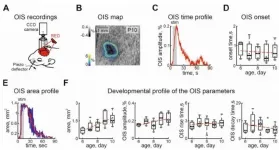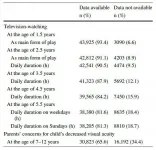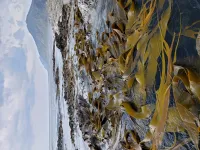Scientists in Asia resumed work far quicker than western counterparts, international COVID lockdown
Research paints a picture of how material scientists were impacted internationally - doctoral students feared for their career. 33% of respondents shut down all equipment, 57% of respondents did not receive mental health support from their institutes.
2021-05-20
(Press-News.org) Researchers in China, Japan, and Singapore were able to resume research much quicker than their counterparts in the US and Europe after the first covid lockdowns, results of a new international survey suggest.
Published 'Open Access' in the peer-reviewed journal Science and Technology of Advanced Materials, the findings of the 'Survey on the effects of the COVID-19 pandemic on research activities of materials scientists', which also included a series of podcasts with eminent experts, highlight how severe the impact of lockdowns affected researchers internationally.
33% of respondents had to shut down all equipment.
The outcomes were not uniform internationally however, as whilst labs in the UK and parts of the USA, Spain, and India were not accessible for the whole of the first lockdown, material scientists in Asian countries were able to access labs within one to two months after the first lockdown.
The conclusions - analysed by a multidisciplinary set of international experts from institutions including University of Electro-Communications in Tokyo, University of York UK, and publishers Taylor & Francis - paint a picture of the lockdowns catching many institutions off guard.
54% of scientists reported that theirs were not prepared or took considerable time to react
and only 44% had contingency plans in place.
This led to additional issues, such as 57% of respondents not receiving mental health support from their institution. In terms of mental health, 40% felt isolation throughout the initial lockdown.
Overall, though, lead author Professor Adarsh Sandhu, from University of ElectroCommunications, states the survey shows a "resilient and adaptive" response from the community.
"The survey showed the materials science community to be resilient and adaptive to overcome limitations imposed by restrictions to mobility as exemplified by the proposal for 'robot-based hubs' to perform remote chemical synthesis similar to astronomers who use remote control to move massive telescopes located all over the world."
As with the majority of the rest of the world, this scientific community (89% of them) used video teleconferencing to complete their work on a day-to-day basis. Again, like for many worldwide, this was not without its issues. Problems reported included unstable internet (nearly 50% reported this problem), an inability to have spontaneous 'coffee time' style meetings (44%), and 36% stated they suffered from fatigue after many hours of teleconferencing.
The virtual nature of work also saw approximately 64% of respondents attended virtual conferences.
One stark finding of the paper was a clear disparity between senior and junior positions, though.
"Responses from doctoral students highlighted their 'fear' and uncertainty as their work suddenly came to a halt and they worried about their careers," co-author Professor Atsufumi Hirohata, from York's Department of Electronic Engineering says.
"However, grad-students also learnt to move forward by using their time to reassess previous data with a view to publishing papers and planning their research."
The survey was carried out from March to October 2020, and, using a database provided by Taylor & Francis, was completed by 298 respondents located in 35 countries.
"Overall, we hope that the analysis from this survey will enable the global materials science community to learn from each other's experiences and move forward from the unprecedented circumstances created by the pandemic," concludes Ken Kimlicka, Global Head of Chemistry/Physics/Materials Science at Taylor & Francis.
Limitations of the research include 74.8% of respondents being male, and 16.7% of respondents being from India - nearly twice as many as from any other country represented.
As part of the wider study internationally, freely-available, online podcast interviews with eminent materials scientists who shared their local experiences during this period can be found by searching for 'The STAM Podcast' on all major providers.
INFORMATION:
ELSE PRESS RELEASES FROM THIS DATE:
2021-05-20
DURHAM, N.C. -- Researchers have discovered a new coronavirus, found in a child with pneumonia in Malaysia in 2018, that appears to have jumped from dog to human.
If confirmed as a pathogen, the novel canine-like coronavirus could represent the eighth unique coronavirus known to cause disease in humans. The discovery also suggests coronaviruses are being transmitted from animals to humans more commonly than was previously thought.
"How common this virus is, and whether it can be transmitted efficiently from dogs to humans or between humans, nobody knows," said Gregory Gray, M.D., a professor of medicine, ...
2021-05-20
Study lead, Research Associate of the Neurobiology Lab Marat Minlebaev explains, "Our brain is a complex mechanism, and it's important to understand how it works. If we understand how our brain functions, we can put forth new treatment methodologies or prevent pathologies, both congenital and acquired."
A number of techniques were used to undertake the research, so, apart from biologists, other scientists were also invited to partake.
"Fourth year students Viktoria Shumkova and Violetta Sitdikova conducted experiments and analyzed their results," says Minlebaev. "To implement the idea, new software was ...
2021-05-20
Researchers from Russia and Germany have created a genome-wide atlas of developmental alternative splicing changes of seven organs in six mammal species and chicken.
The research was published in the journal Nature Genetics.
As the protein encoding RNA matures in eukaryotes, it gets spliced, with some parts cut out and the remaining fragments stitched together. Alternative splicing means that the same RNA fragment can either be cut out from or kept within the mature RNA. In this case, one gene can encode several RNAs and, therefore, several proteins. Although alternative splicing is known to be essential for many tissues to develop and function properly and its various disorders may cause health problems, ...
2021-05-20
It is ingrained in parents to curtail the hours their children spend in front of the television. Anecdotal evidence suggests that prolonged viewing of television and use of smart gadgets during early years can adversely affect a child's eyesight and behavioral development. However, there is little scientific evidence to support such observations on the effects of excessive television exposure on children's visual acuity. Now, Professor MATSUO Toshihiko (M.D., Ph.D.) and Professor YORIFUJI Takashi (M.D., Ph.D.) from Okayama University describe how such exposure can indeed have detrimental effects on children's eyesight during later years.
The researchers used a national database of the Japan Government, based on the annual survey of all children born in the certain period of the ...
2021-05-20
Nerves release a protein at the injury site that attracts growing nerve fibers and thus keeps them entrapped there. This prevents them from growing in the right direction to bridge the injury. The research team headed by Professor Dietmar Fischer reports in the journal Proceedings of the National Academy of Sciences (PNAS) from 25. May 2021.
There must be another cause
Three main causes for the inability of injured nerves of the central nervous system, or CNS, to regenerate have been known to date: the insufficient activation of a regeneration program in injured nerve cells that stimulates the growth of fibers, so-called axons; the formation of a scar at the site ...
2021-05-20
TROY, N.Y. -- Heart disease and cancer are the leading causes of death in the United States, and it's increasingly understood that they share common risk factors, including tobacco use, diet, blood pressure, and obesity. Thus, a diagnostic tool that could screen for cardiovascular disease while a patient is already being screened for cancer, has the potential to expedite a diagnosis, accelerate treatment, and improve patient outcomes.
In research published today in Nature Communications, a team of engineers from Rensselaer Polytechnic Institute and clinicians from Massachusetts General Hospital developed a deep learning algorithm that can help assess a patient's risk of cardiovascular disease ...
2021-05-20
Herndon, Va. (May 20, 2021) - The international journal Risk Analysis has published a timely special issue for May 2021, "Global Systemic Risk and Resilience for Novel Coronavirus and COVID-19." Featuring 11 papers written for this issue over the past year, the collection represents a sampling of insights and viewpoints from scholars across risk sciences and resilience analytics to guide decision-making and operations related to the COVID-19 pandemic.
The 11 papers address the breadth of risk sciences represented by the Society for Risk Analysis (SRA), including risk perception, risk and resilience, human health and ...
2021-05-20
A University of Otago study has revealed how earthquake upheaval has affected New Zealand's coastal species.
Lead author Dr Felix Vaux, of the Department of Zoology, says earthquakes are typically considered devastating events for people and the environment, but the positive opportunities that they can create for wildlife are often overlooked.
For the Marsden-funded study, published in Journal of Phycology, the researchers sequenced DNA from 288 rimurapa/bull-kelp plants from 28 places across central New Zealand.
"All specimens from the North Island were expected to be the species Durvillaea antarctica, but unexpectedly 10 samples from four sites were ...
2021-05-20
WASHINGTON--Yellowstone National Park is famous for harsh winters but a new study shows summers are also getting harsher, with August 2016 ranking as one of the hottest summers in the last 1,250 years.
The new study drew upon samples of living and dead Engelmann spruce trees collected at high elevations in and around Yellowstone National Park to extend the record of maximum summer temperatures back centuries beyond instrumental records. The findings were published in Geophysical Research Letters, AGU's journal for high-impact, short-format reports with immediate implications spanning all Earth and space sciences.
The ...
2021-05-20
Palo Alto, CA--In a new study, researchers found that recreational boats and high-speed ferries contribute significant underwater noise in San Francisco Bay, a highly urbanized coastline that is increasingly becoming a stop along the migratory routes of gray and humpback whales and home to bottlenose dolphins and harbor porpoises.
The study is the first of its kind to use radar to track boats not broadcasting information through the Automatic Identification System (AIS), a navigation safety system required onboard large commercial ships. The findings add to the growing evidence that smaller vessels, ...
LAST 30 PRESS RELEASES:
[Press-News.org] Scientists in Asia resumed work far quicker than western counterparts, international COVID lockdown
Research paints a picture of how material scientists were impacted internationally - doctoral students feared for their career. 33% of respondents shut down all equipment, 57% of respondents did not receive mental health support from their institutes.




